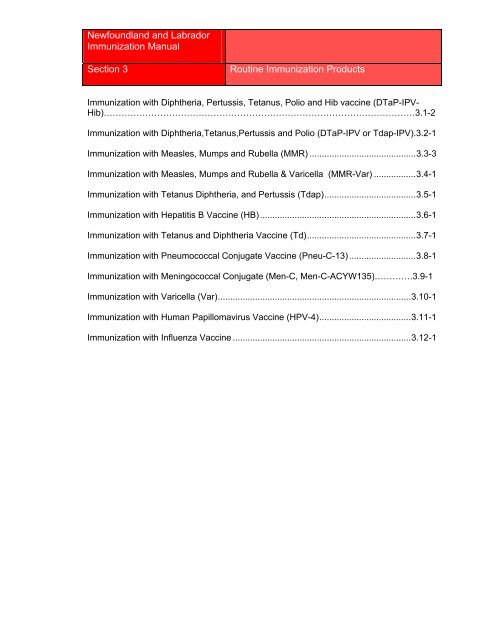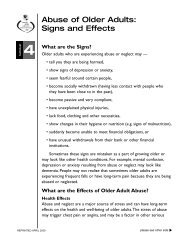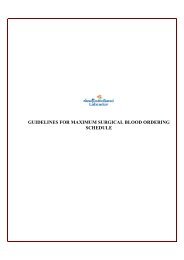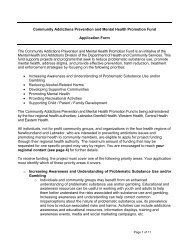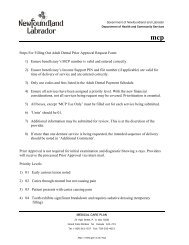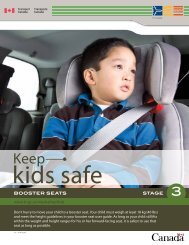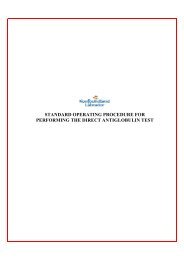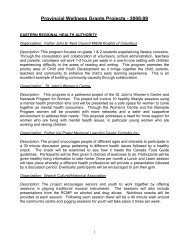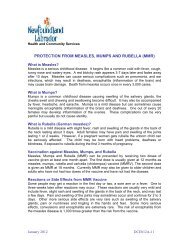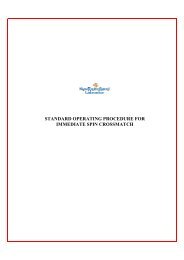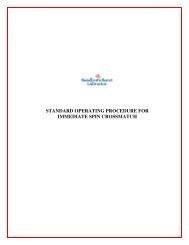Newfoundland and Labrador Immunization Manual Section 3 ...
Newfoundland and Labrador Immunization Manual Section 3 ...
Newfoundland and Labrador Immunization Manual Section 3 ...
- No tags were found...
Create successful ePaper yourself
Turn your PDF publications into a flip-book with our unique Google optimized e-Paper software.
<strong>Newfoundl<strong>and</strong></strong> <strong>and</strong> <strong>Labrador</strong> <strong>Immunization</strong> <strong>Manual</strong> March 2013 Is the child allergic to any component of the vaccine, as listed in the productmonograph? Yes: Defer immunization <strong>and</strong> consult with the MOH/designate. It may be necessaryto immunize in a controlled setting.Has the child had a reaction following a previous dose of DTaP-IPV- Hib or any ofthe constituents of these vaccines?Yes: Determine the nature <strong>and</strong> severity of the reaction. Consult with MOH/designateas required.Is there a history of febrile or afebrile seizure for either the child or a family member?Yes: Give vaccine. Advise that fever reducing medication as per the recommendeddose given just after immunization will reduce the likelihood of a febrile response.Has the child been previously immunized with oral polio vaccine (OPV)?Yes: Give vaccine. A series that has been started with OPV may be completed withthe IPV preparation that is in DTaP- IPV- Hib vaccine.Not contraindicationsHigh fever within 48 hours following last dose of DTaP-IPV-Hib vaccine.Persistent/inconsolable crying for 3 hours or more after last dose of DTaP-IPV-HibvaccinePre-existing neurological conditionsPrevious pertussis diseaseCoagulation disorder (use appropriate gauge needle)PrematurityFamily history of sudden infant death syndromeConvulsion within 48 hours of prior dose of DTaP-IPV-HibMinor illness with or without a feverContraindications Moderate to severe acute illness with or without a fever Children over 59 months of age Allergy to any component of the vaccine or to a previous dose of DTaP-IPV-Hibconsult MOH, controlled setting may be indicated.Consult Medical Officer of Health For children who have experienced hypotonic hyporesponsive episodes followingprevious immunization with DTaP-IPV-Hib.Routine <strong>Immunization</strong> Products 3.1-3
<strong>Newfoundl<strong>and</strong></strong> <strong>and</strong> <strong>Labrador</strong> <strong>Immunization</strong> <strong>Manual</strong> March 20133.2 <strong>Immunization</strong> with Diphtheria, Tetanus, Pertussis <strong>and</strong> Polio(DTaP-IPV)*PolicyThe <strong>Newfoundl<strong>and</strong></strong> <strong>and</strong> <strong>Labrador</strong> schedule provides DTaP-IPV* for children at age 4 - 6years, as a booster to the primary series. If child’s immunization schedule has beeninterrupted, see <strong>Section</strong> 2 of this manual or the CIGDescription of VaccineCombined preparation of toxoids (diphtheria <strong>and</strong> tetanus), acellular vaccine (pertussis)<strong>and</strong> inactivated vaccine (polio).DTaP-IPV is indicated for booster immunization of children age 4-6 years. Immunizesagainst diphtheria, tetanus, pertussis, <strong>and</strong> polio.Related InformationSee product monograph for exact description of vaccineSee Canadian <strong>Immunization</strong> Guide (current edition) for latex <strong>and</strong> product informationControl of Communicable Diseases <strong>Manual</strong> (current edition)Dose:Route:Site:0.5 mlIntramuscularVastus lateralis in infants <strong>and</strong> children under 12 months of age.Deltoid in children age 12 months <strong>and</strong> over (unless muscle mass is notadequate).Procedure <strong>and</strong> Preparation for Injection: Follow product monographScreening Guidelines: See section 1.5 for additional screening informationScreening Questions Is the child allergic to any component of the vaccine, as listed in the productmonograph?Yes: Defer immunization <strong>and</strong> consult with the MOH/designate. It may be necessaryto immunize in a controlled setting.Does the child have a moderate to severe illness, with or without a fever?Yes: Defer immunization with DTaP-IPV vaccine until the child is well.Is the child on antibiotic medication?Yes: Give vaccine. Antibiotic medication is not a contraindication to immunization,provided that the child is well enough to be immunized.Is the child seven years of age?Yes: Do not give DTaP-IPV, see delayed schedule section 2.Routine <strong>Immunization</strong> Products 3.2-1
<strong>Newfoundl<strong>and</strong></strong> <strong>and</strong> <strong>Labrador</strong> <strong>Immunization</strong> <strong>Manual</strong> March 2013Has the child been previously immunized with oral polio vaccine (OPV)?Yes: Give DTaP-IPV. A series that has been started with OPV may be completedwith the IPV preparation that is in DTaP-IPV vaccine.Not contraindicationsHigh fever within 48 hours following last dose of a vaccinePersistent/inconsolable crying for 3 hours or more after last dose of a vaccinePre-existing neurological conditionsPrevious pertussis diseaseCoagulation disorder (use appropriate gauge needle)PrematurityFamily history of sudden infant death syndromeConvulsion within 48 hours of prior dose of DTaP-IPVMinor illness with or without a feverContraindicationsModerate to severe acute illness with or without a feverAllergy to any component of DTaP-IPV-Hib vaccine (consult MOH, controlled settingmay be indicated)Children older than 7 yearsConsult Medical Officer of Health For children who have experienced hypotonic hyporesponsive episodes followingprevious immunization with DTaP-IPV-Hib.*Tdap-IPV may be used instead of DTaP-IPV for the 4 - 6 year primary seriesboosterRoutine <strong>Immunization</strong> Products 3.2-2
<strong>Newfoundl<strong>and</strong></strong> <strong>and</strong> <strong>Labrador</strong> <strong>Immunization</strong> <strong>Manual</strong> March 20133.3 <strong>Immunization</strong> with Measles, Mumps <strong>and</strong> Rubella (MMR)PolicyThe <strong>Newfoundl<strong>and</strong></strong> <strong>and</strong> <strong>Labrador</strong> schedule provides MMR for children at age 18 months.If child’s immunization schedule has been interrupted or delayed, see <strong>Section</strong> 2 of thismanual or the CIG.As of January 2012 MMR vaccine will be provided as a combined vaccine with varicellavaccine in a single injection, as MMRV at age 12 months.Related InformationSee product monograph for exact description of vaccineSee Canadian <strong>Immunization</strong> Guide (current edition) for latex <strong>and</strong> product informationControl of Communicable Diseases <strong>Manual</strong> (current edition)Dose:Route:Site:0.5 mlSubcutaneouslySubcutaneous tissue in the upper armNote: This must be different anatomical site {at least 2.5 cm (1 inch)}away than other vaccines.Procedure <strong>and</strong> Preparation for Injection: Follow product monographScreening Guidelines: See section 1.5 for additional screening informationScreening QuestionsIs the child 12 months of age or older?Yes: Give MMRV at 12 months <strong>and</strong> MMR at 18 monthsHas the child had an anaphylactic reaction to a previous dose of MMR or any of thecomponents as listed in the product monograph?Yes: Do NOT give MMR; anaphylaxis to a previous dose is a contraindication, as is asevere allergy to any components of the vaccine. Consult with the MOH/designate.Does the child have a moderate to severe acute illness with or without a fever?Yes: Defer MMR until person is well.Is the child immunocompromised?MMR should not be given to any person who has severe immunodeficiency. See CIG<strong>and</strong> defer MMR <strong>and</strong> consult with the MOH/designate as required.Is the child taking steroids or corticosteroid therapy?Yes: Defer MMR <strong>and</strong> consult with the MOH/designate as required. Depending onthe route, dose <strong>and</strong> duration of therapy, there may be no need to delayadministration of MMR. Low to moderate doses of steroid therapy has not beenassociated with compromised immunity.Routine <strong>Immunization</strong> Products 3.3-3
<strong>Newfoundl<strong>and</strong></strong> <strong>and</strong> <strong>Labrador</strong> <strong>Immunization</strong> <strong>Manual</strong> March 2013Is there a recent history of blood transfusion or immune globulin therapy?Yes: Defer MMR. There is a requirement for an interval of at least 3 months betweenthe administration of immune globulins or blood <strong>and</strong> live measles vaccination. Pleasesee the CIG for additional information.Does the child have any febrile respiratory or active febrile illness (including TB)?Yes: Defer MMR until person is well.Is there a possibility that the person may be pregnant?Yes: Defer MMR until the postpartum. Advise that pregnancy should be avoided forone month following immunization (see CIG).If the child has received a dose of MMR prior to the first birthday should they still begiven MMRV at 12 <strong>and</strong> MMR at 18 months?Yes: Give MMRV at 12 months <strong>and</strong> MMR at 18 months, a dose given prior to the firstbirthday is disregarded.The person requires a tuberculosis skin test, can they receive MMR?Can be done on the same day; MMR can suppress a positive TB skin test, thereforeif TB testing is required it should be done the same day or delayed for 4 weeks afterthe MMR is given. Refer to CIG or <strong>Section</strong> 3 of the <strong>Newfoundl<strong>and</strong></strong> TuberculosisGuideline for more information.Not contraindications Minor illness with or without a fever Coagulation disorder (use appropriate gauge needle) Contact with a case of active tuberculosis History of an allergy to eggs, chicken, feathers or egg products Breastfeeding Recently been exposed to measles Uncertain immunization history re. MMRContraindications Allergy to any component of MMR or a previous dose of MMR (consult MOH,controlled setting may be indicated) Pregnancy Moderate to severe acute illness with or without a fever Any febrile respiratory or active febrile illness (including TB) Persons who are immunocompromised Children younger than 12 monthsConsult Medical Officer of Health For children taking steroids or corticosteroid therapy For children with an allergy to any component of MMR or a previous dose of MMR For children under age 12 months traveling to an area of endemic measlesRoutine <strong>Immunization</strong> Products 3.3-4
<strong>Newfoundl<strong>and</strong></strong> <strong>and</strong> <strong>Labrador</strong> <strong>Immunization</strong> <strong>Manual</strong> March 20133.4 <strong>Immunization</strong> with Measles, Mumps <strong>and</strong> Rubella &Varicella (MMR-Var)PolicyThe <strong>Newfoundl<strong>and</strong></strong> <strong>and</strong> <strong>Labrador</strong> schedule provides MMR-Var for healthy children atage 12 months, at the same clinic visit as Men-C-C <strong>and</strong> Pneu-Conjugate. If child’simmunization schedule has been interrupted, see <strong>Section</strong> 2 of this manual or the CIG.The immunization must be given on or after the first birthday.Description of VaccineRelated InformationSee product monograph for exact description of vaccineSee Canadian <strong>Immunization</strong> Guide (current edition) for latex <strong>and</strong> product informationControl of Communicable Diseases <strong>Manual</strong> (current edition)Dose:0.5 mlRoute: SubcutaneouslySite:Subcutaneous tissue in the upper armNote: This must be different anatomical site {at least 2.5 cm (1 inch) away}than other vaccines.Procedure <strong>and</strong> Preparation for Injection: Follow product monographScreening Guidelines: See section 1.5 for additional screening informationScreening QuestionsHas the person had chickenpox after one year of age?YES: Do not give MMR-Var only MMR is required. Note: if the person has or hadillness prior to one year give MMR-Var.NO or unsure of history of varicella: give MMR-Var.Has the person had an anaphylactic reaction to a previous dose of MMR-Var or anyof the components as listed in the product monograph?Yes: Do NOT give MMR-Var; anaphylaxis to a previous dose is a contraindication,as is a severe allergy to any components of the vaccine.Does the person have a moderate to severe acute illness with or without a fever?Yes: Defer MMR-Var until person is well.Is the person immunocompromised?MMR-Var should not be given to any person who has severe immunodeficiency.There are also warnings <strong>and</strong> precautions related to close contacts that areimmunocompromised. See product monograph <strong>and</strong> CIG in this case <strong>and</strong> consultwith the MOH/designate as required.Routine <strong>Immunization</strong> Products 3.4-1
<strong>Newfoundl<strong>and</strong></strong> <strong>and</strong> <strong>Labrador</strong> <strong>Immunization</strong> <strong>Manual</strong> March 2013Is the person taking steroids or corticosteroid therapy?Yes: Defer MMR-Var <strong>and</strong> consult with the MOH/designate as required. Dependingon the route, dose <strong>and</strong> duration of therapy, there may be no need to delayadministration of MMR-Var. Low to moderate doses of steroid therapy has not beenassociated with compromised immunity.Is there a recent history of blood transfusion or immune globulin therapy?Yes: Defer MMR-Var. There is a requirement for an interval of at least 3 monthsbetween the administration of immune globulins or blood <strong>and</strong> live measlesvaccination. Please see the product monograph <strong>and</strong> CIG for additional information.Does the person have any febrile respiratory or active febrile illness (including TB)?Yes: Defer MMR-Var until person is well.Is there a possibility that the person may be pregnant?Yes: Defer MMR-Var until the postpartum. Advise that pregnancy should be avoidedfor one month following immunization (see CIG).The person requires TB testing; can they receive MMR-Var?YES with caution; MMR-Var is a live vaccine <strong>and</strong> can temporarily depress thereactivity of the Mantoux test. If TST is required it should be done before orsimultaneously to a live vaccine, or deferred 4-6 weeks.If the child has received a dose of MMR prior to the first birthday should they still begiven a dose at 12 <strong>and</strong> 18 months?Yes: Give MMR-Var at 12 months <strong>and</strong> MMR at 18 months, a dose given prior to thefirst birthday is disregarded. Is the person older equal to or older than 13 years?Yes: Do not give MMR-Var, give MMR <strong>and</strong> Var as there is no indication for use ofMMR-Var in persons equal to or older than age 13 years.Note: Salicylates should be avoided for 6 weeks after MMR-Var, as Reye’s syndromehas been reported following the use of salicylates during natural varicella infection.Acetaminophen, Advil <strong>and</strong> Motrin are not salicylates.Not contraindicationsMinor illnessCoagulation disorder (use appropriate gauge needle)Contact with a case of active tuberculosisHistory of an allergy to eggs, chicken, feathers or egg productsBreastfeedingRecently been exposed to measlesUncertain immunization history re. MMRContraindicationsAllergy to any component of MMR-Var or a previous dose of MMR-Var (consultMOH, controlled setting may be indicated)PregnancyModerate to severe acute illness with or without a feverAny febrile respiratory or active febrile illness (including TB)Routine <strong>Immunization</strong> Products 3.4-2
<strong>Newfoundl<strong>and</strong></strong> <strong>and</strong> <strong>Labrador</strong> <strong>Immunization</strong> <strong>Manual</strong> March 2013Persons who are immunocompromisedPersons equal to or older than 13 years should not receive MMR-VarConsult Medical Officer of HealthIf person had an allergic reaction to any components of the vaccine or has had anallergic reaction to a previous dose of the vaccineRoutine <strong>Immunization</strong> Products 3.4-3
<strong>Newfoundl<strong>and</strong></strong> <strong>and</strong> <strong>Labrador</strong> <strong>Immunization</strong> <strong>Manual</strong> March 20133.5 <strong>Immunization</strong> with Tetanus Diphtheria, <strong>and</strong>Pertussis (Tdap)PolicyThe <strong>Newfoundl<strong>and</strong></strong> <strong>and</strong> <strong>Labrador</strong> schedule provides Tdap for children in Grade 9, at age14 - 16 years. If child’s immunization schedule has been interrupted, see <strong>Section</strong> 2 ofthis manual or the CIG.Description of VaccineCombined preparation of toxoids (diphtheria <strong>and</strong> tetanus), acellular vaccine (pertussis).Tdap is indicated for booster immunization of children age 14-16 years, but may be usedfor children aged 7 <strong>and</strong> over. Tdap protects against tetanus, diphtheria <strong>and</strong> pertussis.Related InformationSee product monograph for exact description of vaccineSee Canadian <strong>Immunization</strong> Guide (current edition) for latex <strong>and</strong> product informationControl of Communicable Diseases <strong>Manual</strong> (current edition)Dose:Route:Site:0.5 mlIntramuscularDeltoidProcedure <strong>and</strong> Preparation for Injection: Follow product monographScreening Guidelines: See section 1.5 for additional screening informationScreening Questions Is the person allergic to any component of the vaccine, as noted in the productmonograph?Yes: Defer immunization <strong>and</strong> consult with the MOH/designate. It may be necessaryto immunize in a controlled setting. Has the child had a reaction following a previous dose of Tdap or any of theconstituents of these vaccines?Yes: Determine the nature <strong>and</strong> severity of the reaction. Consult with MOH/designateas required.Does the person have a moderate to severe illness, with or without a fever?Yes: Defer Tdap until the person is well.Has the person received Td immunization recently?Yes: Proceed with immunization. There is no longer a time interval required betweenthe administration of Td <strong>and</strong> TdapRoutine <strong>Immunization</strong> Products 3.5-1
<strong>Newfoundl<strong>and</strong></strong> <strong>and</strong> <strong>Labrador</strong> <strong>Immunization</strong> <strong>Manual</strong> March 2013Not contraindicationsMinor illness with or without a feverAntibiotic medicationCoagulation disorder (use appropriate gauge needle)No previous doses of pertussis vaccinePrevious pertussis illnessInhaled steroidsContraindicationsAllergy to any component of Tdap or a previous dose of DTaP-IPV-Hib or DTaP-IPVModerate to severe acute illness with or without a feverConsult Medical Officer of HealthIf person received tetanus immunization within the last five yearsIf person had an allergic reaction to any components of the vaccine or has had anallergic reaction to a previous dose of the vaccineRoutine <strong>Immunization</strong> Products 3.5-2
<strong>Newfoundl<strong>and</strong></strong> <strong>and</strong> <strong>Labrador</strong> <strong>Immunization</strong> <strong>Manual</strong> March 20133.6 <strong>Immunization</strong> with Hepatitis B Vaccine (HB)PolicyThe <strong>Newfoundl<strong>and</strong></strong> <strong>and</strong> <strong>Labrador</strong> schedule provides hepatitis B vaccine for children ingrade six as a two dose schedule. The hepatitis B vaccine is indicated for activeimmunization against hepatitis B, pre-exposure, <strong>and</strong> post-exposure management. See<strong>Section</strong> 5 in <strong>Newfoundl<strong>and</strong></strong> <strong>and</strong> <strong>Labrador</strong> <strong>Immunization</strong> <strong>Manual</strong> for the immunizationprogram for high-risk groups.Description of VaccineRecombinant of vaccine containing purified hepatitis B surface antigen (HBsAg).Related InformationProduct monograph for exact description of vaccine <strong>and</strong> latex contentCanadian <strong>Immunization</strong> Guide (current edition)Control of Communicable Diseases <strong>Manual</strong> (current edition)Dose: Varies by product <strong>and</strong> age at time of administration, please see CIG <strong>and</strong>product monographRoute: IntramuscularSite: Deltoid in children age 12 months <strong>and</strong> over (unless inadequate muscle mass)Vastus lateralis in infants <strong>and</strong> children under 12 months of age.Procedure <strong>and</strong> Preparation for Injection: Follow product monograph.Screening Guidelines: See section 1.5 for additional screening information.Screening Questions Is the person allergic to any component of the vaccine, as listed in the productmonograph?Yes: Defer immunization <strong>and</strong> consult with the MOH/designate. It may benecessary to immunize in a controlled setting.Has the person had a reaction following a previous dose of hepatitis B vaccine orany of the constituents of the vaccine?Yes: Determine the nature <strong>and</strong> severity of the reaction. Consult withMOH/designate as required.Does the person have a moderate to severe illness, with or without a fever?Yes: Defer immunization with HB vaccine until person is well.Routine <strong>Immunization</strong> Products 3.6-1
<strong>Newfoundl<strong>and</strong></strong> <strong>and</strong> <strong>Labrador</strong> <strong>Immunization</strong> <strong>Manual</strong> March 2013Not contraindicationsMinor illness with or without a feverAntibiotic medicationCoagulation disorder (use appropriate gauge needle)BreastfeedingContraindicationsAllergy to any component of hepatitis B vaccineAcute moderate to severe illness with or without a feverConsult Medical Officer of HealthIf person had an allergic reaction to any components of the vaccine or has had anallergic reaction to a previous dose of the vaccineRoutine <strong>Immunization</strong> Products 3.6-2
<strong>Newfoundl<strong>and</strong></strong> <strong>and</strong> <strong>Labrador</strong> <strong>Immunization</strong> <strong>Manual</strong> March 20133.7 <strong>Immunization</strong> with Tetanus <strong>and</strong> Diphtheria Vaccine (Td)PolicyThe <strong>Newfoundl<strong>and</strong></strong> <strong>and</strong> <strong>Labrador</strong> schedule provides Td as a booster dose every 10years for adults who have had a primary series.Description of VaccineCombined preparation of tetanus <strong>and</strong> diphtheria toxoids. Td is indicated for boosterimmunization of adults. Immunizes against diphtheria <strong>and</strong> tetanus.Related InformationSee product monograph for exact description of vaccineSee Canadian <strong>Immunization</strong> Guide (current edition) for latex <strong>and</strong> product informationControl of Communicable Diseases <strong>Manual</strong> (current edition)Dose:Route:Site:0.5mlIntramuscularDeltoidProcedure <strong>and</strong> Preparation for Injection: Follow product monographScreening Guidelines: See section 1.5 for additional screening informationScreening QuestionsDoes the person have an allergy to any component of the vaccine as listed in theproduct monograph?Yes: Defer immunization <strong>and</strong> consult with the MOH/designate as required. It may benecessary to immunize in a controlled setting. Has the person had a reaction following a previous dose of tetanus containingvaccine or any of the constituents of the vaccine?Yes: Determine the nature <strong>and</strong> severity of the reaction. Consult withMOH/designate as requiredDoes the person have knowledge of having received a tetanus <strong>and</strong> diphtheria toxoidcontaining vaccine in the last ten years?No: Proceed with immunization. There is no longer a time interval required betweenthe administration of tetanus <strong>and</strong> diphtheria toxoid containing vaccine.Does the person have a moderate to severe illness, with or without a fever?Yes: Defer immunization with Td vaccine until the person is well.Routine <strong>Immunization</strong> Products 3.7-1
<strong>Newfoundl<strong>and</strong></strong> <strong>and</strong> <strong>Labrador</strong> <strong>Immunization</strong> <strong>Manual</strong> March 2013Not contraindicationsMinor illness with or without a feverAntibiotic medicationCoagulation disorder (use appropriate gauge needle)Inhaled steroidsContraindicationsAllergy to any component of Td or a previous dose of DTaP-IPV-HibAcute moderate to severe illness with or without a feverConsult Medical Officer of Health:If person had an allergic reaction to any components of the vaccine or has had anallergic reaction to a previous dose of the vaccineRoutine <strong>Immunization</strong> Products 3.7-2
<strong>Newfoundl<strong>and</strong></strong> <strong>and</strong> <strong>Labrador</strong> <strong>Immunization</strong> <strong>Manual</strong> March 20133.8 <strong>Immunization</strong> with Pneumococcal Conjugate Vaccine (Pneu-C-13)PolicyThe <strong>Newfoundl<strong>and</strong></strong> <strong>and</strong> <strong>Labrador</strong> schedule provides pneumococcal conjugate vaccine tothe following:1. One dose of Pneu-C-13 at 2, 4, <strong>and</strong> 12 months for all children beginning primaryseries on January 1, 2012.2. One dose of Pneu-C-13 at 2, 4, 6 <strong>and</strong> 12 months for high risk children beginningprimary series on January 1, 2012 at increased risk for invasive pneumococcaldisease or complications of pneumococcal infections. Those at high risk include,but are not limited to: Chronic cardiac disease Chronic respiratory disease (excludes asthma) Chronic renal disease Chronic neurological disease with risk of an aspiration, or cerebrospinalfluid leak Documented immune disorder associated with recurrent infections Diabetes mellitus Hodgkin's disease, lymphoma, multiple myeloma <strong>and</strong> inducedimmunosuppression Bronchial pulmonary dysplasia or other severe respiratory disease relatedto prematurity Asplenia or splenic dysfunction Cirrhosis of the liver Sickle-cell disease Persons with cochlear implants Aboriginal children.3. For children age 7 months through 59 months of age not previously immunizedwith pneumococcal vaccine the following schedule applies:Age at First Dose Total number of 0.5 mL doses7-11 months of age 3*12-23 months of 2†age≥ 24 months 1through 5 years ofage (prior to the 6 thbirthday)*2 doses at least 4 weeks apart; third dose after the one-year birthday, separatedfrom the second dose by at least 2 months.†2 doses at least 2 months apart4. The Pneumococcal Polysaccharide 23 <strong>and</strong> Pneumococcal Conjugate 13 vaccineprogram is available for children age ≥24 months <strong>and</strong> other cohorts who are atRoutine <strong>Immunization</strong> Products 3.8-1
<strong>Newfoundl<strong>and</strong></strong> <strong>and</strong> <strong>Labrador</strong> <strong>Immunization</strong> <strong>Manual</strong> March 2013increased risk for disease; see section 5.4 of the <strong>Newfoundl<strong>and</strong></strong> <strong>and</strong> <strong>Labrador</strong><strong>Immunization</strong> <strong>Manual</strong> for a description of these groups.Description of VaccineEach 0.5 ml of Pneu-C-13 contains 13 pneumococcal serotypes with diphtheria CRM197ProteinRelated InformationSee product monograph for exact description of vaccineSee Canadian <strong>Immunization</strong> Guide (current edition)Control of Communicable Diseases <strong>Manual</strong> (current edition)Dose: 0.5 mlRoute: IntramuscularSite: Vastus lateralis in infants <strong>and</strong> children under 12 months of age.Deltoid in children age 12 months <strong>and</strong> over (unless muscle mass is not adequate).Procedure <strong>and</strong> Preparation for Injection: Follow product monograph.Screening Guidelines: See section 1.5 for additional screening information.Screening QuestionsHas the child had an anaphylactic reaction to a previous dose of Pneu-C-13 orcomponent of the vaccine as listed in the product monograph?Yes: DO NOT give Pneu-C-10 or Pneu-C-13Does the child have a moderate to severe illness, with or without a fever?Yes: Defer immunization with vaccine until child is well.Has the child had a previous dose of Pneu-P-23 vaccine?Yes: There is a minimal 8 week interval between Pneu-P-23 <strong>and</strong> Pneu- C-13.Not Contraindications Mild illness Child is on an antibiotic Previous dose of Pneu-P-23 (there is a minimal 8 week interval) Coagulation disorder (use appropriate gauge needle)Contraindications Anaphylaxis to a previous dose of Pneu-C-13 or to any of the components of thevaccine or the stopper. Acute moderate to severe illness with or without a feverRoutine <strong>Immunization</strong> Products 3.8-2
<strong>Newfoundl<strong>and</strong></strong> <strong>and</strong> <strong>Labrador</strong> <strong>Immunization</strong> <strong>Manual</strong> March 20133.9 <strong>Immunization</strong> with Meningococcal Conjugate (Men-C, Men-C-ACYW135)PolicyThe <strong>Newfoundl<strong>and</strong></strong> <strong>and</strong> <strong>Labrador</strong> schedule provides meningococcal conjugate vaccinefor children aged 12 months, born after January 1 2004. This vaccine is indicated foractive immunization of children aged two months or older <strong>and</strong> adults or close contacts ofa person with meningococcal type C disease. The publicly funded program includes:One dose given at 12 months of age or after, at the same clinic visit as MMR <strong>and</strong>varicella. Children in grade 4 will receive one dose of Men-C-ACYW135 as part of theprovincial catch up program. This catch up program will end in the school year 2012-13.Description of VaccineEach vial of Men-C vaccine contains 0.5mL suspension of the Neisseria meningitidisserogroup C oligosaccharide conjugate.Each vial of Men-C-ACYW135 vaccine contains 0.5mL suspension of the Neisseriameningitidis serogroups A, C, Y <strong>and</strong> W135 capsular polysaccharide antigens individuallyconjugated to diphtheria toxoid protein.Related InformationSee product monograph for exact description of vaccineSee Canadian <strong>Immunization</strong> Guide (current edition) for latex <strong>and</strong> product informationControl of Communicable Diseases <strong>Manual</strong> (current edition)Dose:Route:Site:0.5 mlIntramuscularVastus lateralis in infants <strong>and</strong> children under 12 months of age.Deltoid in children age 12 months <strong>and</strong> over (unless muscle mass is notadequate).Procedure <strong>and</strong> Preparation for Injection: Follow product monographScreening Guidelines: See section 1.5 for additional screening informationScreening Questions Has the person had an anaphylactic reaction to a previous dose of Men-C(meningococcal vaccine) or are they allergic to a component of the vaccine as listedin the product monograph?Yes: Do NOT give Men-C.Does the person have a moderate to severe acute illness with or without a fever?Yes: Defer Men-C until person is well.Routine <strong>Immunization</strong> Products 3.9-1
<strong>Newfoundl<strong>and</strong></strong> <strong>and</strong> <strong>Labrador</strong> <strong>Immunization</strong> <strong>Manual</strong> March 2013Is the person immunocompromised?Yes: Men-C may be given but the person may not mount the same immuneresponse.Has the person had a previous dose of polysaccharide meningococcal vaccine?Yes: Men-C or Men-C-ACYW135 may be given as long as a six month period haspassed since the original vaccination.Has the person received a previous dose of Men-C?Yes: This is age dependant vaccine, if a previous dose was given after age one yearno further doses are required. If the child is less than one year of age, please seeCIGNot contraindicationsMinor illness with or without a feverCoagulation disorder (use appropriate gauge needle)Active tuberculosisContact with a case of active tuberculosisPrevious dose of meningococcal polysaccharide vaccine or uncertain immunizationhistory or meningococcal diseaseTaking antibioticsContraindications Known hypersensitivity to any component see above Pregnancy or for lactating mothers consult with MOH Moderate to severe acute illness with or without a fever Previous dose of meningococcal polysaccharide vaccine with the original dosereceive in the last 6 months Previous dose of Men C (if child is less than 1 year of age, see CIG)Consult Medical Officer of HealthIf person had an allergic reaction to any components of the vaccine or has had anallergic reaction to a previous dose of the vaccineRoutine <strong>Immunization</strong> Products 3.9-2
<strong>Newfoundl<strong>and</strong></strong> <strong>and</strong> <strong>Labrador</strong> <strong>Immunization</strong> <strong>Manual</strong> March 20133.10 <strong>Immunization</strong> with Varicella (Var)PolicyThe <strong>Newfoundl<strong>and</strong></strong> <strong>and</strong> L abrader schedule provides varicella vaccine for children oneyear <strong>and</strong> older <strong>and</strong> adults, who have not had varicella disease, including: At school entry (age 4-6 years) at the same visit as DTaP-IPV or Tdap-IPV, if notpreviously immunized.Health Care Workers who are non-immuneAs of January 2012 varicella vaccine will be given at 12 months or after, ascombined with MMR vaccine in a single injection as MMR-Var, at the same clinic visitas Men C-C & Pneu-C-13 (See section 3.4 for MMR-Var policy)Children with a history of varicella illness prior to one year of age will receive MMR-Var.Description of VaccineWhen reconstituted with sterile water one dose (0.5 ml) contains live attenuated virus forsubcutaneous injection.Related InformationSee product monograph for exact description of vaccineSee Canadian <strong>Immunization</strong> Guide (current edition)Control of Communicable Diseases <strong>Manual</strong> (current edition)Dose:Route:Site:0.5 mlSubcutaneouslySubcutaneous tissue in the upper armNote: This must be different anatomical site {at least 2.5 cm (1 inch) away} than othervaccinesProcedure <strong>and</strong> Preparation for Injection: Follow product monographScreening Guidelines: See section 1.5 for additional screening informationScreening QuestionsHas the person had chickenpox after one year of age?YES: Do not give MMR-Var. Note: if the person had illnesses prior to one year giveMMR-Var.No or unsure of history of varicella: Give MMR-Var if under age 13; give Var if equalto or older than 13 years; give Var if person has previously had two MMRs.Has the person had an anaphylactic reaction to a previous dose of Var or anycomponents as listed in the product monograph?YES: Do not give Var. Does the person have moderate to severe acute illness with or without fever?Routine <strong>Immunization</strong> Products 3.10-1
<strong>Newfoundl<strong>and</strong></strong> <strong>and</strong> <strong>Labrador</strong> <strong>Immunization</strong> <strong>Manual</strong> March 2013YES: Defer Var until the person is well. If the person is on chronic salicylic acidtherapy or antiviral drugs consult CIG.Is the person immunocompromised?YES: Var may be given in some cases, consult your local MOH/designate.Is the person taking corticosteroid therapy?YES: Defer Var <strong>and</strong> consult with the MOH/designate as required. Depending uponthe route, dose <strong>and</strong> duration of therapy, there may be no need to delay theadministration of Var. Low to moderate doses of steroid therapy has not beenassociated with compromised immunity.Is there a recent history of blood transfusion or immune globulin therapy?YES: Defer Var. There is a requirement of minimum of three months intervalbetween the administration of immune globulins or blood <strong>and</strong> live vaccines. Refer toCIG for further information.Is there a possibility that the person may be pregnant?YES: Defer Var until the postpartum. Advise that pregnancy should be avoided forone month after live vaccine.The person requires TB testing, can they receive Var?YES with caution; Var is a live vaccine <strong>and</strong> can temporarily depress the reactivity ofthe Mantoux test. If TST is required it should be done before or simultaneously to alive vaccine, or deferred 4-6 weeks.The person has active untreated TB can they receive Var?NO: Consult with MOH/ designate.Note: Salicylates should be avoided for 6 weeks after Var, as Reye’s syndrome hasbeen reported following the use of salicylates during natural varicella infection. Feverreducing medication, Advil <strong>and</strong> Motrin are not salicylates.Not ContraindicationsMinor illness with or without feverContact with an active case of TBHistory of an allergy to eggs, chicken, feathers or egg productsBreastfeedingCoagulation disorder (use appropriate gauge needle)Uncertain history of immunization or varicella diseaseTaking antibioticsContraindicationsHypersensitivity to any component or the vaccine, or to a previous dose of VarPregnancyPersons with active untreated TBPersons who are immunocompromisedModerate to severe acute illness with or without feverPersons who have had chickenpox after 1 year of ageHistory of blood transfusions or immune globulin therapy within the last 3 monthsRoutine <strong>Immunization</strong> Products 3.10-2
<strong>Newfoundl<strong>and</strong></strong> <strong>and</strong> <strong>Labrador</strong> <strong>Immunization</strong> <strong>Manual</strong> March 2013Consult Medical Officer of Health: If person had an allergic reaction to any components of the vaccine or has had anallergic reaction to a previous dose of the vaccine For persons who are immunocompromised For persons receiving corticosteroid therapyRoutine <strong>Immunization</strong> Products 3.10-3
<strong>Newfoundl<strong>and</strong></strong> <strong>and</strong> <strong>Labrador</strong> <strong>Immunization</strong> <strong>Manual</strong> March 20133.11 <strong>Immunization</strong> with Human Papillomavirus Vaccine (HPV-4)PolicyThe <strong>Newfoundl<strong>and</strong></strong> <strong>and</strong> <strong>Labrador</strong> schedule provides the HPV-4 vaccine for females inGrade 6 given in a three dose schedule.Product DescriptionQuadrivalent HPV-4 vaccine consists of the L1 capsid protein of each of four types HPVstrains (types 6, 11, 16 <strong>and</strong>18). A gene encoding the L1 protein of each type isexpressed in the yeast Saccharomyces cerevisiae. The protein product self-assemblesinto a non–infectious virus-like particle (VLP) that is identical in shape <strong>and</strong> size to thenatural virus. This is a vaccine indicated for females 9-26 years of age.Related InformationSee product monograph for exact description of vaccineSee Canadian <strong>Immunization</strong> Guide (current edition) for latex <strong>and</strong> product informationControl of Communicable Diseases <strong>Manual</strong> (current edition)Dose: Administered in three (3) separate 0.5mL doses, using 0, 2 <strong>and</strong> 6 monthsschedule.See product monograph for interrupted vaccine schedule.Route:Site:IntramuscularDeltoid region of the upper armReconstitution Procedure <strong>and</strong> Preparation for Injection: See productmonograph.Screening Guidelines: See section 1.5 for additional screening informationScreening QuestionsHas the person had an anaphylactic reaction to a previous dose of HPV vaccine orare they allergic to a component of the vaccine as listed in the product monograph?Yes: Do NOT give HPV vaccineIs the individual allergic to any component of the vaccine, as listed in the productmonograph?Yes: Defer immunization <strong>and</strong> consult with the MOH/designate. Has the individual developed symptoms of hypersensitivity after receiving a HPVvaccine?Yes: Do not administer any further doses.Does the individual have a moderate to severe illness, with or without a fever?Yes: Defer immunization with vaccine until individual is well.Routine <strong>Immunization</strong> Products 3.11-1
<strong>Newfoundl<strong>and</strong></strong> <strong>and</strong> <strong>Labrador</strong> <strong>Immunization</strong> <strong>Manual</strong> March 2013Is the individual pregnant?Yes: Do not give vaccine.Not ContraindicationsMinor illness with or without a feverIndividual is on an antibioticBreastfeedingCoagulation disorder (use appropriate gauge needle)ContraindicationsAnaphylaxis to a previous dose of HPV vaccine or to any of the components of thevaccinePregnancyModerate to severe illness with or without a feverConsult Medical Officer of HealthIf person had an allergic reaction to any components of the vaccine or has had anallergic reaction to a previous dose of the vaccineRoutine <strong>Immunization</strong> Products 3.11-2
<strong>Newfoundl<strong>and</strong></strong> <strong>and</strong> <strong>Labrador</strong> <strong>Immunization</strong> <strong>Manual</strong> March 20133.12 <strong>Immunization</strong> with Influenza VaccinePolicyThe <strong>Newfoundl<strong>and</strong></strong> <strong>and</strong> <strong>Labrador</strong> schedule recommends <strong>and</strong> provides influenza vaccinefor individuals in several groups during the influenza season (fall – winter) please seesection 5.3-1 for details of eligibility.Description of vaccineChanges yearly for influenza season please see product monograph for description.Related Information See product monograph for exact description of vaccine See National Advisory Committee on <strong>Immunization</strong> statement 2011-12 See Canadian <strong>Immunization</strong> Guide (current edition) for latex <strong>and</strong> product information Control of Communicable Diseases <strong>Manual</strong> (current edition)Dose: Recommended dose may change per influenza season or by product. Alwaysverify dose with product monograph.Table 3.11-1: Recommended Influenza Vaccine Dosage by AgeAge Dosage( mL) Number of dosesrequired6 months -8 years 0.5 1 or *2≥9 years 0.5 1*Children previously unvaccinated < 9yrs of age require two does of trivalent influenza vaccine (TIV) with aminimum interval of 4 weeks between doses. Eligible children < 9 years of age who have properly receivedone or more doses of TIV in the past are recommended to receive one dose per season thereafter.Route:Site:IntramuscularThe anterolateral thigh is recommended site in infants between 6 months<strong>and</strong> 12 months of age, deltoid region of the upper arm for ≥12 months ofage.Reconstitution Procedure <strong>and</strong> Preparation for Injection: See productmonograph.Screening Guidelines: See section 1.5 for additional screening informationScreening QuestionsIs the individual allergic to any component of the vaccine, as listed in the productmonograph?Yes: Defer immunization <strong>and</strong> consult with the MOH/designate.Routine <strong>Immunization</strong> Products 3.12-1
<strong>Newfoundl<strong>and</strong></strong> <strong>and</strong> <strong>Labrador</strong> <strong>Immunization</strong> <strong>Manual</strong> March 2013Has the individual developed symptoms of hypersensitivity after receiving aninfluenza vaccine?Yes: Do not administer any further doses.Does the individual have a moderate to severe illness, with or without a fever?Yes: Defer immunization with vaccine until individual is wellDoes the individual report a mild egg allergy?Yes: Administer if person reports mild allergy (can eat eggs without a reaction)Yes: Administer if reaction include hives but observe client for reaction for 30minutesNo: Do not administer If reaction includes symptoms of hypotension, wheezing,nausea, vomiting or if reaction required epinephrine. Refer to a physician withexpertise in management of allergic conditionsDoes the individual report a severe allergic reaction to eggs?Yes: Do not administer if reaction includes symptoms of cardiovascular changes,severe gastrointestinal symptoms, respiratory distress, if the reaction requiredepinephrine, or medical attention. Consult MOH, Referral to a physician withexpertise in management of allergic conditions may be necessary.Not ContraindicationsMinor illness with or without a feverIndividual is on an antibioticPregnancyBreastfeedingCoagulation disorder (use appropriate gauge needle)Allergy to eggsContraindicationsAnaphylaxis to a previous dose of Influenza vaccine or to any of the components ofthe vaccineModerate to severe illness with or without a feverConsult Medical Officer of HealthIf person had an allergic reaction to any components of the vaccine or has had anallergic reaction to a previous dose of the vaccineRoutine <strong>Immunization</strong> Products 3.12-2


